Serviços Personalizados
Journal
Artigo
Indicadores
-
 Citado por SciELO
Citado por SciELO -
 Acessos
Acessos
Links relacionados
-
 Similares em
SciELO
Similares em
SciELO
Compartilhar
Revista de Ciências Agrárias
versão impressa ISSN 0871-018X
Rev. de Ciências Agrárias vol.41 no.spe Lisboa dez. 2018
https://doi.org/10.19084/RCA.17075
ARTIGO
Caracterisation of Puccinia hemerocallidis causing the first outbreak of daylily rust in Europe
Caracterização de Puccinia hemerocallidis causadora do primeiro surto de ferrugem de lírio-de-um-dia na Europa
Rita Carvalho1, Elsa Silva1, João Loureiro2, Ana Paula Ramos1 and Pedro Talhinhas1,*
1 LEAF-Linking Landscape, Environment, Agriculture and Food, Instituto Superior de Agronomia, Universidade de Lisboa. Lisboa, Portugal
2 CFE, Centro de Ecologia Funcional, Departamento de Ciências da Vida, Universidade de Coimbra. Coimbra, Portugal
(*E-mail: ptalhinhas@isa.ulisboa.pt)
ABSTRACT
Daylily (Hemerocallis spp.) is an ornamental plant widely used in gardens. Daylily rust, caused by the fungus Puccinia hemerocallidis, has disseminated through all continents only in the 21th century, except in Europe, where it has been considered a quarantine disease by the European Plant Protection Organisation. In Portugal, since November 2015, typical rust symptoms were observed in daylily plants in gardens in Lisbon, Alentejo, Algarve and Madeira, attaining high prevalence, incidence and severity. The causal agent was identified as P. hemerocallidis and the Koch’s postulates were fulfilled. Phylogenetic data suggest that this fungus may have been introduced from North America. Using flow cytometry, the genome size of the P. hemerocallidis populations present in Portugal was estimated to be 345 Mbp (0.3533 pg DNA/1C). For such analysis Rhamnus alaternus was validated as a DNA standard, exhibiting a nuclear content of 0.680 pg DNA/2C. The identification of this disease in diverse locations in Portugal represents a threat to European breeding and nursery industries, since there are the appropriate conditions for inoculum maintenance and propagation from Portugal to the rest of Europe.
Keywords: Puccinia hemerocallidis, Hemerocallis, daylily, quarantine, Europe.
RESUMO
O lírio-de-um-dia (Hemerocallis spp.) é uma planta ornamental muito utilizada em jardins. A ferrugem de lírio-de-um-dia, causada pelo fungo Puccinia hemerocallidis, disseminou-se por todos os continentes já no século 21, com exceção da Europa, onde tem sido considerada uma doença de quarentena pela Organização Europeia de Proteção das Plantas. A partir de novembro de 2015 foram observados sintomas de ferrugem em plantas de lírio-de-um-dia em jardins de Lisboa, Alentejo, Algarve e Madeira, com elevados níveis de prevalência, incidência e severidade. O agente causal foi identificado como P. hemerocallidis, tendo sido cumpridos os postulados de Koch. Dados filogenéticos sugerem que a introdução do fungo poderá ter ocorrido a partir da América do Norte. Através do uso da citometria de fluxo, o tamanho do genoma das populações de P. hemerocallidis presentes em Portugal foi estimado em 345 Mbp (0,3533 pg DNA/1C). Para tal, Rhamnus alaternus foi validado como padrão de DNA, exibindo uma constituição nuclear de 0,680 pg DNA/2C. A identificação desta doença em diversos locais em Portugal representa uma ameaça para os melhoradores e viveiristas europeus de lírio-de-um-dia, já que existem condições para a manutenção e propagação de inóculo a partir de Portugal para o resto da Europa.
Palavras-chave: Puccinia hemerocallidis, Hemerocallis, lírio-de-um-dia, quarentena, Europa.
Daylily (or Hemerocallis) is an ornamental plant appreciated by its long flowering period and strong chromatic coverage. It comprises the species Hemerocallis lilioasphodelus L. or interspecific hybrids with neighbouring species, including H. minor Mill., clustered in the family Xanthorrhoeaceae. The species have originated in Eastern Asia (Russia, Korea, Japan and China), but it has adapted to various climates, being cultivated from the tropics to high latitudes, with tens of thousands of varieties being present in public and private gardens throughout the world.
Daylily rust, caused by the fungus Puccinia hemerocallidis von Thümen, was first described in 1880 on H. fulva L. in Eastern Russia (von Thümen, 1880). However, it was not until the 21st century that the disease was reported out of Asia. In fact, in a period of only seven years the disease was reported in North America in 2000 (Williams-Woodward et al., 2001), in South America in 2001 (Carvalho et al., 2001), in Oceania in 2002 (EPPO, 2002) and in Africa in 2007 (Mostert et al., 2008) (Figure 1). Infected material was also detected in Europe in plants exported from the USA to the UK in 2001 and 2002, but the disease was detected on arrival and did not establish (Jones & Sansford, 2005). Thus, the European Plant Protection Organisation listed this pathogen in the A1 list of quarantine diseases (EPPO, 2015).
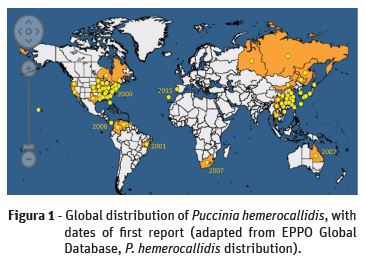
In Portugal, since November 2015, typical rust symptoms were observed in daylily plants in gardens in Lisbon, Alentejo, Algarve and Madeira, attaining 66% prevalence (the disease was present in six out of nine gardens surveyed), incidence (symptoms in 85-90% of the daylily plants) and severity (25-75% of the leaf surface covered with rust pustules) (Silva et al., 2016). Symptoms included small lesions originating orange/yellow urediniosporic sori on the upper page of the leaves, over which brown teleutosporic sori subsequently developed (Figure 2). Severe infections lead to defoliation and loss of vigour and of ornamental value of the plants (Figure 3). The microscopic examination of fungal structures led to the identification of P. hemerocallidis and the Koch’s postulates were fulfilled, confirming this fungus as the causal agent of daylily rust (Silva et al., 2016).
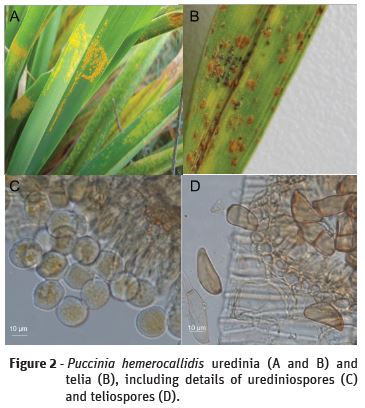
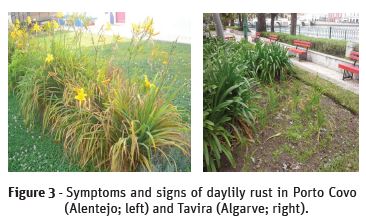
Urediniospores collected from a single pustule from infected material collected at Porto Covo (Alentejo) were used for DNA extraction using a phenol:chlorophorm protocol (Talhinhas et al., 2003) adapted to 1.5mL tubes. The rDNA-ITS region was amplified and sequenced as previously described (Talhinhas et al., 2002). The nucleotide sequence (Table 1) matches entirely those of P. hemerocallidis from the USA and Costa Rica, while revealing to be distinct from those from other continents (Figure 4), suggesting a North- or Central-American origin of the Portuguese daylily rust outbreak. The fact that only one Portuguese sample was analysed does not enable to rule out the hypothesis of multiple introductions. On the other hand, no sequences from South American, South African or Central/Southern Asian samples are available for comparison.
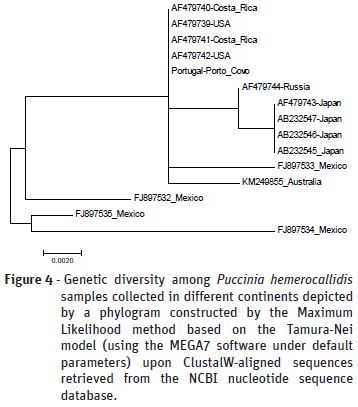
To further characterise the pathogen, and because no information was available for P. hamerocallidis, rust-infected leaf material was also used for genome size estimation by flow cytometry, by employing the nuclei isolation protocol developed by Loureiro et al. (2007) and optimized for rust fungi by Tavares et al. (2014). Samples were analysed using a CyFlow Space flow cytometer (Sysmex, Germany), with Raphanus sativus L. ‘Saxa’ (1.11 pg DNA/2C) and Cenococcum geophilum Fr. isolate 844.1 (0.208 pg DNA/1C) as reference standards (Doleel et al., 1998; Talhinhas et al., 2017. Additionally, Rhamnus alaternus L. (from populations naturally occurring at Tapada da Ajuda, Lisbon) was validated as DNA standard by comparison with C. geophilum, Raphanus sativus and Solanum lycopersicum L. ‘Stupické’ (1.96 pg DNA/2C; Doleel et al., 1992) (Figure 5), presenting a genome size of 0.680±0.028 pg DNA/2C. The genome size of P. hemerocallidis was thus estimated to be 345 Mbp (0.3533 ± 0.0210 pg DNA/1C) (Figure 6), a similar value to the average genome size for the Pucciniales reported by Ramos et al. (2015), i.e., 351 Mbp, further reinforcing the outstanding genome size of Pucciniales fungi, which are approximately seven times larger than the average fungal genome sizes (Talhinhas et al., 2015). The host plant was also compared to Vicia faba L. ‘Inovec’ (26.65 pg DNA/2C; Doleel et al., 1992), suggesting that it is diploid (9.72 pg DNA per nucleus) according to Podwyszyńska et al. (2015).
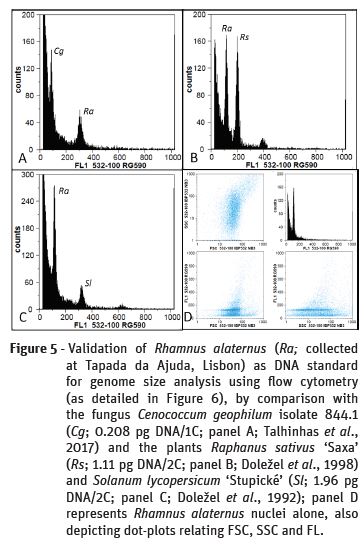
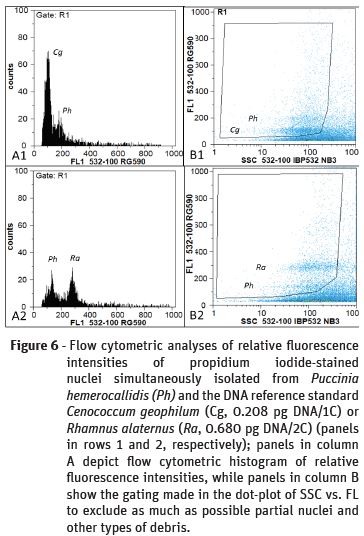
Puccinia hemerocallidis is a macrocyclic heteroaecious fungus, having Patrinia spp. (Valerianaceae) as aecial hosts. Patrinia spp. do not occur out of East Asia. In cool climates daylilies lose their leaves in winter and, in the absence of the aecial host, the disease cycle is naturally broken, as urediniospores are incapable of overwintering. However, in climates with mild winter, most daylily genotypes retain their leaves, creating appropriate conditions for inoculum maintenance and survival. This contrasting scenario occurs between the North and South of the USA (Williams-Woodward et al., 2001) and it is likely to remain valid in contrasting climates in Europe. The identification of daylily rust in Portugal, for the first time in Europe, is therefore relevant, on one hand because the Mediterranean climate conditions in Portugal will enable inoculum survival, and on the other hand because the Western location of this country favours inoculum dispersal East- and Northeast-wards by the dominant winds. In the USA, Mueller et al. (2003) and Blythe et al. (2015) showed that most cultivars are susceptible to the disease, although some exhibit resistance. Following the protocol by Loureiro et al. (2015), we have inoculated P. hemerocallidis urediniospores on daylily leaves collected from three different gardens in the Lisbon area (unknown cultivars) and all proved susceptible to the disease. There are over 3000 cultivars available in catalogues across Europe, many of which were European-bred, and only 10 of those were included in the study by Blythe et al. (2015), none being rated as resistant. It is therefore crucial that the resistance of the European cultivars is characterized, in advance of a hypothetical entry of the pathogen in other European countries. Additionally, Buck (2013) suggested the occurrence of physiological races in P. hemerocallidis, although neither a race differentiation system nor accompanying molecular data are available yet. Such results and the questions that remain to be answered suggest research topics that may help the management of daylily rust in Europe, along with experimental data on the biology, epidemiology and control of this pathogen (Mueller & Buck, 2003; Buck et al., 2010, 2011; Dong & Buck, 2011; Dong et al., 2013). The challenge is now on European plant pathologists and daylily breeders to join efforts to plan and deploy the most effective plant protection strategies in order to maintain the economic and aesthetical value of daylilies, while minimizing the employment of pesticides in nurseries and public gardens. While basing breeding programmes in selected resistant germplasm should provide a durable mid- to long-term disease control strategy, in the short terms all players should take extra-care when obtaining propagating material from parts of the world where the disease is present, report and destroy foci of disease and avoid the continuous presence of foliage in gardens or nurseries (thus breaking the urediniosporic cycle) namely by choosing cultivars with longer deciduous periods.
References
Blythe, E.K.; Pounders, C.; Anderson, M. Watts, E. & Watts, B. (2015) - Survey of 575 Daylily Cultivars for Severity of Day lily Rust in a Southern Mississippi Landscape. HortTechnology, vol. 25, n. 4, p. 551-564. [ Links ]
Buck, J.W. (2013) - Identification of Pathotypes in the Daylily Rust Pathogen Puccinia hemerocallidis. Journal of Phytopathology, vol. 161, n. 11-12, p. 784-790. http://dx.doi.org/10.1111/jph.12134 [ Links ]
Buck, J.W.; Dong, W. & Mueller, D.S. (2010) - Effect of light exposure on in vitro germination and germ tube growth of eight species of rust fungi. Mycologia, 102, n. 5, p. 1134-1140. https://doi.org/10.3852/09-283 [ Links ]
Buck, J.W.; Wise, K. & Dong, W. (2011) - Effect of postsymptom application of fungicides on urediniospore production by Puccinia triticina on wheat and P. hemerocallidis on daylily. Plant Disease, vol. 95, n. 3, p. 325-330. https://doi.org/10.1094/PDIS-09-10-0646 [ Links ]
Carvalho Jr, A.A.; Coutinho, L.N. & Figueiredo, M.B. (2001) - A primeira constatação da ferrugem do lírio-de-São-José nas Américas. Arquivos do Instituto Biológico, vol. 68, p. 57. [ Links ]
Doleel, J.; Greilhuber, J.; Lucretti, S.; Meister, A.; Lysák, M.A.; Nardi, L. & Obermayer, R. (1998) - Plant genome size estimation by flow cytometry: inter-laboratory comparison. Annals of Botany, vol. 82, n. S1, p. 17–26. https://doi.org/10.1093/oxfordjournals.aob.a010312 [ Links ]
Doleel, J.; Sgorbati, S. & Lucretti, S. (1992) - Comparison of three DNA fluorochromes for flow cytometric estimation of nuclear DNA content in plants. Physiologia Plantarum, vol. 85, n. 4, p. 625–631. http://dx.doi.org/10.1111/j.1399-3054.1992.tb04764.x [ Links ]
Dong, W. & Buck, J.W. (2011) - Effect of light on in vivo urediniospore germination, lesion development and sporulation of Puccinia hemerocallidis on daylily and Puccinia pelargonii-zonalis on geranium. Mycologia, vol. 103, n. 6, p. 1277-1283. https://doi.org/10.3852/11-047 [ Links ]
Dong, W.B.; Jeffers, S.N. & Buck, J.W. (2013) - Management of daylily rust with different fungicides and application methods. Plant Disease, vol. 97, n. 7, p. 921-926. https://doi.org/10.1094/PDIS-12-12-1127-RE [ Links ]
EPPO (2002) - First report of Puccinia hemerocallidis in Australia. EPPO Reporting Service, vol. 2002, p. 038. [ Links ]
EPPO (2009) - Puccinia hemerocallidis. EPPO Bulletin, vol. 39, p. 48-50. [ Links ]
EPPO (2015) - EPPO A1 and A2 lists of pests recommended for regulation as quarantine pests. EPPO, Paris. [ Links ]
Jones, D.R. & Sansford, C. (2005) - CSL Pest Risk Analysis for Puccinia hemerocallidis. Central Science Laboratory. [cit. 2017.12.19]. <https://secure.fera.defra.gov.uk/phiw/riskRegister/downloadExternalPra.cfm?id=3916> [ Links ]
Loureiro, A.; Azinheira, H.G.; Silva, M.C. & Talhinhas, P. (2015) - A method for obtaining RNA from Hemileia vastatrix appressoria produced in planta, suitable for transcriptomic analyses. Fungal Biology, vol. 119, n. 11, p. 1093-1099. https://doi.org/10.1016/j.funbio.2015.08.008 [ Links ]
Loureiro, J.; Rodriguez, E.; Doleel, J. & Santos, C. (2007) - Two new nuclear isolation buffers for plant DNA flow cytometry: a test with 37 species. Annals of Botany, vol. 100, n. 4, p. 875-888. https://dx.doi.org/10.1093%2Faob%2Fmcm152 [ Links ]
Mostert, L.; Bester, W. & Coertze, S. (2008) - First Report of Daylily Rust Caused by Puccinia hemerocallidis in the Western Cape Province of South Africa. Plant Disease, vol. 92, n. 7, p. 1133. https://doi.org/10.1094/PDIS-92-7-1133A [ Links ]
Mueller, D.S. & Buck, J.W. (2003) - Effects of light, temperature, and leaf wetness duration on daylily rust. Plant Disease, vol. 87, n. 4, p. 442-445. http://dx.doi.org/10.1094/PDIS.2003.87.4.442 [ Links ]
Mueller, D.S.; Williams-Woodward, J.L. & Buck, J.W. (2003) - Resistance of daylily cultivars to the daylily rust pathogen, Puccinia hemerocallidis. HortScience, vol. 38, n. 6, p. 1137-1140. [ Links ]
Podwyszyńska, M.; Gabryszewska, E.; Dyki, B.; Stępowska, A.A.; Kowalski, A. & Jasiński, A. (2015) - Phenotypic and genome size changes (variation) in synthetic tetraploids of daylily (Hemerocallis) in relation to their diploid counterparts. Euphytica, vol. 203, n. 1, p. 1-16. https://doi.org/10.1007/s10681-014-1212-3 [ Links ]
Ramos, A.P.; Tavares, S.; Tavares, D.; Silva, M.C.; Loureiro, J. & Talhinhas, P. (2015) - Flow cytometry reveals that the rust fungus Uromyces bidentis (Pucciniales) possesses the largest fungal genome reported, 2,489 Mbp. Molecular Plant Pathology, vol. 16, n. 9, p. 1006-1010. http://dx.doi.org/10.1111/mpp.12255 [ Links ]
Silva, E.; Carvalho, R.; Nunes, N.; Ramos, A.P. & Talhinhas, P. (2016) - First Report of Puccinia hemerocallidis Causing Daylily Rust in Europe. Plant Disease, vol. 100, n. 10, p. 2163. https://doi.org/10.1094/PDIS-02-16-0242-PDN [ Links ]
Talhinhas, P.; Neves-Martins, J. & Leitão, J. (2003) - AFLP, ISSR and RAPD markers reveal high levels of genetic diversity among Lupinus species. Plant Breeding, vol. 122, n. 6, p. 507-510. http://dx.doi.org/10.1111/j.1439-0523.2003.tb01772.x [ Links ]
Talhinhas, P.; Ramos, A.P.; Tavares, D.; Tavares, S. & Loureiro, J. (2015) - Genome size estimates for six rust (Pucciniales) species. Revista de Ciências Agrárias, vol. 38, n. 2, p. 176-183. [ Links ]
Talhinhas, P.; Sreenivasaprasad, S.; Neves-Martins, J. & Oliveira, H. (2002) - Genetic and morphological characterisation of Colletotrichum acutatum causing anthracnose of lupins. Phytopathology, vol. 92, n. 9, p. 986-996. https://doi.org/10.1094/PHYTO.2002.92.9.986 [ Links ]
Talhinhas, P.; Tavares, D.: Ramos, A.P.; Gonçalves, S. & Loureiro, J. (2017) - Validation of standards suitable for genome size estimation of fungi. Journal of Microbiological Methods, vol. 142, p. 76-78. https://doi.org/10.1016/j.mimet.2017.09.012 [ Links ]
Williams-Woodward, J.L.; Hennen, J. F.; Parda, K.W. & Fowler, J.M. (2001) – First report of daylily rust in the United States. Plant Disease, vol. 85, n. 10, p. 1121. http://dx.doi.org/10.1094/PDIS.2001.85.10.1121C [ Links ]
von Thümen, F. (1880) - Beiträge zur Pilz-Flora Sibiriens. Bulletin of Moscow Society of Naturalists, vol. 55,p. 72-104. [ Links ]
Acknowledgements
The Fundação para a Ciência e a Tecnologia (FCT, Portugal) is acknowledged for support to the project PTDC/BIA-MIC/1716/2014 and for support to the research units LEAF (UID/AGR/04129/2013) and CFE (UID/BIA/04004/2013). Project ReNATURE - Valorization of the Natural Endogenous Resources of the Centro Region (Centro 2020, Centro-01-0145-FEDER-000007) is also fully acknowledged.
Received/recebido: 2018.01.16
Accepted/aceite: 2018.03.12














